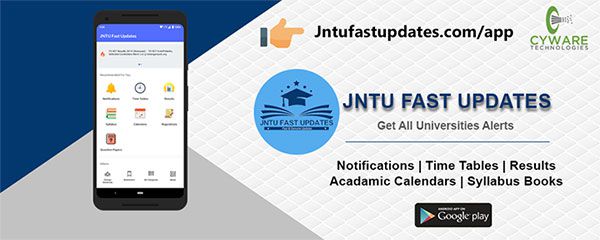JNTUK R19 3-1 Power Systems-II Material/Notes PDF Download
Students those who are studying JNTUK R19 EEE Branch, Can Download Unit wise R19 3-1 Power Systems-II Material/Notes PDFs below.

JNTUK R19 3-1 Power Systems-II Material/Notes PDF Download
Preamble: This course is an extension of power systems–I course. It deals with basic theory of transmission lines modeling and their performance analysis. Transient in power system, improvement of power factor and voltage control are discussed in detail. It is important for the student to understand the mechanical design aspects of transmission lines, cables, insulators. These aspects are also covered in detail in this course.
OBJECTIVES:
- To compute inductance/capacitance of transmission lines and to understand the concepts of GMD/GMR.
- To study the short and medium length transmission lines, their models and performance.
- To study the performance and modeling of long transmission lines.
- To study the effect of travelling waves on transmission lines.
- To study the factors affecting the performance of transmission lines and power factor improvement methods.
- To discuss sag and tension computation of transmission lines as well as to study the performance of overhead insulators.
UNIT-1
Transmission Line Parameters Conductor materials – Types of conductors – Calculation of resistance for solid conductors – Calculation of inductance for single phase and three phase– Single and double circuit lines– Concept of GMR and GMD–Symmetrical and asymmetrical conductor configuration with and without transposition–Bundled conductors – Calculation of capacitance for 2 wire and 3 wire systems – Effect of ground on capacitance – Capacitance calculations for symmetrical and asymmetrical single and three phase–Single and double circuit lines- Bundled conductors.
Download UNIT-1 Material PDF | Reference-2 | Ref-3
UNIT–2:
Performance Analysis of Transmission Lines Classification of Transmission Lines – Short, medium, long line and their model representations –Nominal-T–Nominal-Pie and A, B, C, D Constants for symmetrical and Asymmetrical Networks.
Rigorous Solution for long line equations – Surge Impedance and SIL of Long Lines – Representation of Long lines – Equivalent T and Equivalent Pie network models – Mathematical Solutions to estimate regulation and efficiency of all types of lines.
Download UNIT-2 PART Material PDF | Reference-2 | Ref-3
UNIT–3:
Power System Transients Types of System Transients – Travelling or Propagation of Surges – Attenuation–Distortion– Reflection and Refraction Coefficients – Termination of lines with different types of conditions – Open Circuited Line–Short Circuited Line – T-Junction– Lumped Reactive Junctions.
Download UNIT-3 Material PDF | Reference-2
UNIT–4:
Various Factors governing the Performance of Transmission line Skin and Proximity effects – Description and effect on Resistance of Solid Conductors –Ferranti effect – Charging Current – Corona – Description of the phenomenon–Factors affecting corona– Critical voltages and power loss – Radio Interference.
UNIT–5:
Sag and Tension Calculations and Overhead Line Insulators Sag and Tension calculations with equal and unequal heights of towers–Effect of Wind and Ice on weight of Conductor – Stringing chart and sag template and its applications–Types of Insulators – String efficiency and Methods for improvement – Voltage distribution–Calculation of string efficiency – Capacitance grading and Static Shielding.
Download UNIT-5 Material PDF | Reference-2
TEXT BOOKS:
- Electrical power systems – by C.L.Wadhwa, New Age International (P) Limited, Publishers, 1998.
- Modern Power System Analysis by I.J.Nagarath and D.P.Kothari, Tata McGraw Hill, 2ndEdition
REFERENCE BOOKS:
- Power system Analysis–by John J Grainger William D Stevenson, TMC Companies, 4thedition
- Power System Analysis and Design by B.R.Gupta, Wheeler Publishing.
- A Text Book on Power System Engineering by M.L.Soni, P.V.Gupta, U.S.BhatnagarA.Chakrabarthy, DhanpatRai& Co Pvt. Ltd.
- Electrical Power Systems by P.S.R. Murthy, B.S.Publications.
OUTCOMES:
- Able to understand parameters of various types of transmission lines during different operating conditions.
- Able to understand the performance of short and medium transmission lines.
- Student will be able to understand travelling waves on transmission lines.
- Will be able to understand various factors related to charged transmission lines.
- Will be able to understand sag/tension of transmission lines and performance of line insulators


320-x100(1).gif)

please change the power system transients notes in app it is not 3 Rd chapter it is 4th chapter